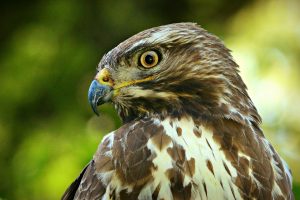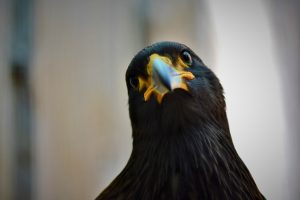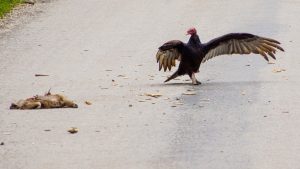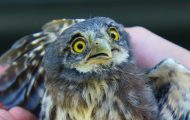Have you ever wondered, “How do buzzards find food?” These majestic birds are fascinating creatures with a unique way of tracking their next meal. Buzzards, also known as birds of prey, typically feed on small mammals and carrion. Their uncanny ability to locate food in diverse environments, from sprawling open fields to dense forests, has long intrigued wildlife enthusiasts and scientists alike.
This article aims to unravel the mystery behind their exceptional food-finding tactics, offering intriguing insights into their behaviors and survival strategies. Therefore, stick around for an enlightening exploration if you’ve ever been curious about the world from a buzzard’s-eye view.
The Remarkable Vision of Buzzards
 When spotting potential meals from high in the sky, buzzards have a distinct advantage, their extraordinary vision. Imagine having sharp eyesight that you can spot a rabbit in a field nearly a mile away. Quite impressive, isn’t it? That’s the world as seen through a buzzard’s eyes.
When spotting potential meals from high in the sky, buzzards have a distinct advantage, their extraordinary vision. Imagine having sharp eyesight that you can spot a rabbit in a field nearly a mile away. Quite impressive, isn’t it? That’s the world as seen through a buzzard’s eyes.
These birds are typically classified as daytime hunters, mainly due to their reliance on superior vision for locating food. They possess an incredibly high number of sensory cells in the retina, specifically designed for sharp focus and recognizing minute movements. This keen eyesight, coupled with a broad field of view, empowers buzzards to survey vast landscapes from high above, effortlessly spotting potential meals.
So, while you may need binoculars to enjoy the view from a tall building, a buzzard only needs its natural, finely-tuned visual prowess.
Buzzards’ Sense of Smell
 Now, you may wonder, “Is vision the only sense buzzards rely on to find their food?” Interestingly, while sight is unquestionably crucial in their hunt, it isn’t the only tool in their survival toolkit. Let’s focus on another important sense – the buzzards’ sense of smell.
Now, you may wonder, “Is vision the only sense buzzards rely on to find their food?” Interestingly, while sight is unquestionably crucial in their hunt, it isn’t the only tool in their survival toolkit. Let’s focus on another important sense – the buzzards’ sense of smell.
Unlike humans, buzzards have a highly developed olfactory system. While our noses may scrunch up at the scent of carrion to a buzzard, it’s as tantalizing as the aroma of a freshly baked pie is to us. The fascinating fact is that buzzards can detect decomposing animals’ smells from incredible distances. This natural ‘superpower’ proves particularly useful when their visual prowess is hindered – for instance, in dense forests where sight lines can be obscured.
Thus, depending on the environment and prey availability, a buzzard can seamlessly switch between its super-sharp vision and an exceptional sense of smell. This multi-modal approach to hunting ensures that the bird rarely goes hungry and continues to reign supreme in the food chain. In the world of buzzards, it’s all about using the right sense at the right time, and this adaptability makes these creatures such fascinating subjects of study.
Buzzards in Action: A Closer Look at Their Hunting Techniques

Ever watched a buzzard in full flight and wondered, “Just how do they do it?” Buzzards are not just incredible aviators; they’re also masterful hunters!
🦅 Soaring and Scanning
Have you ever looked up to the sky and seen a bird gently gliding, circling without flapping its wings, and wondered how it does it? That’s a buzzard performing an incredible aerial ballet called Soaring and scanning.
Soaring is more than just a picturesque bird-flight scene; it’s a strategic hunting technique that buzzards have perfected over millions of years. They leverage thermals, which are updrafts of warm air that naturally occur in the environment.
As the sun heats the earth’s surface, pockets of warm air rise, forming these invisible columns that buzzards ride on, much like an elevator. They circle within these thermals to gain altitude without exerting much energy by flapping their wings.
Now comes the scanning part. As the buzzard soars high in the sky, its remarkably sharp vision comes into play. It scans the ground below, looking for signs of potential prey. The height gives them a panoramic view, allowing them to monitor large areas of land with ease. If a buzzard spots something tasty, it will gracefully exit the thermal and start a controlled descent toward its target.
This soaring and scanning technique shows the remarkable adaptation of buzzards to their environment. They combine physics, meteorology, and sharp predatory instincts to find their next meal. It’s a testament to the intricate dance of survival in nature, where every move is choreographed for optimum efficiency.
🦅 Perching and Pouncing
You’ve probably seen birds perched on telephone wires or tree branches, haven’t you? Often, they’re simply resting or enjoying the view. But when a buzzard perches, it’s often more than just a leisurely break. This is the beginning of what we call the “Perching and Pouncing” technique.
You see, buzzards don’t always have to soar high in the sky to find food. Sometimes they find it more efficient to sit still and let their food come to them. This is particularly true in environments with plenty of cover for small mammals to hide, such as forests or hedgerows.
As the buzzard sits patiently, it keeps its keen eyes and sharp senses locked onto its surroundings. It springs into action once it spots potential prey – maybe a mouse, a rabbit, or some unsuspecting creature rustling in the undergrowth.
In an instant, the buzzard launches itself from its perch and swoops down on its prey, capturing it with its powerful talons. It’s swift, efficient, and surprising, giving the prey little chance of escaping. This “Perching and Pouncing” technique is yet another stunning display of the buzzard’s adaptability and hunting prowess.
Social Behavior: Buzzards’ Collaborative Hunting Strategy
It’s time to talk about buzzards’ social behavior, which is yet another fascinating aspect of their lifestyles. You might be thinking, “Wait, buzzards are social creatures?” Well, yes, they are! In fact, their social behavior plays a significant role in their hunting strategies.
Have you ever observed a group of buzzards circling in the air together? While it might appear they’re just enjoying some shared flight time, there’s much more going on here. They’re teaming up to increase their chances of securing a meal!
Here’s how it works: The buzzards spread out, covering a larger area than a single bird could manage alone. They’re casting a wider net, increasing their chances of spotting potential prey. As soon as one buzzard spots a meal, it swoops down, and the others follow. It’s a cooperative hunting strategy that’s as efficient as it is impressive!
But it’s not just about hunting together. Buzzards also communicate with each other about the location of food through specific calls and signals. Think of it as the buzzard version of “Hey, dinner’s ready!” These communication skills are key to their survival, especially in harsh environments where food can be scarce.
Buzzards’ Cuisine: Not Picky, Just Surviving

If buzzards were invited to a potluck, they’d probably be the easiest guests to cater for! Why, you ask? Well, because these birds are anything but picky eaters. Their dietary habits are impressive; they’re flexible, adaptable, and opportunistic – which is a fancy way of saying they’ll eat pretty much anything that fits in their beak!
Let’s start with the buzzard’s favorite: small mammals. If you’re a field mouse, a rabbit, or a vole, you must watch out for these flying predators. These creatures form the main course of the buzzard’s diet, and trust me; they are experts at hunting them down. The “Perching and Pouncing” technique we talked about earlier? That’s often used to catch these unsuspecting little creatures.
But what about when times are tough and small mammals are in short supply? Not a problem for our adaptable buzzards! They’re just as happy to switch to birds and reptiles when they need to. You’ll even find them chowing down on earthworms, insects, and amphibians. It’s all about survival, after all.
And let’s not forget carrion – the buzzard’s ‘fast food’ option. When the opportunity arises, buzzards will feast on the carcasses of animals that have met their end by other means. It might seem a bit gruesome to us, but to a buzzard, it’s a free meal – and who can pass up on that?
Remarkably, buzzards also eat a small amount of plant material. Berries, grains, seeds – you name it, they’ll try it. It’s not a significant part of their diet. Still, it’s a fascinating little fact that adds to their image as the ultimate survivors.
So there you have it: the eclectic and survival-driven menu of the buzzard. As you can see, these birds are not fussy about their food. Their adaptability is key to their survival, and it’s a testament to the fascinating diversity of nature’s creatures. If you’re still curious, here’s a video about everything you need to know about buzzards.
Frequently Asked Questions
Q: How do buzzards find food like the turkey vulture and black vulture?
Turkey vultures use their keen sense of smell to find carrion (dead animals). They can detect the scent of rotten meat from a mile away, often flying low enough to detect the beginnings of decomposition. On the other hand, black vultures, another common species in North America, rely more on their vision to locate food, often tracking other scavenger birds or predators to a food source.
Q: Are buzzards and vultures the same?
While the terms are often used interchangeably, there is a difference between buzzards and vultures. In North America, “buzzard” commonly refers to the turkey vulture, a large bird that feeds on carrion. However, in other parts of the world, like Europe, a buzzard refers to a different species. This common buzzard is a predator rather than a scavenger.
Q: Why do we often see vultures circling in the sky?
Vultures circle in the sky for two main reasons: to find food and to conserve energy. Their large wings allow them to ride wind currents while they use their excellent sight or smell to locate carrion. When one finds a good updraft, other vultures will join it, forming what’s known as a kettle of vultures. This behavior is especially common among turkey vultures in both North and South America.
Q: What impact do vultures have on the ecosystem?
Vultures play a crucial role in our ecosystem as nature’s cleanup crew. By feeding on carrion, they help prevent the spread of diseases that could be harmful to other animals and even humans. Their decline, therefore, could have serious implications for the health of other species and livestock. Efforts are being made to protect and increase the global vulture population.
Q: What are some distinctive features of vultures?
Vultures are large birds with broad wings and strong, hooked beaks perfect for tearing into carrion. They also have bald heads devoid of feathers to keep them clean as they eat. Their dark plumage allows them to blend into their surroundings, making them less noticeable to potential threats. Different species have various distinctive features, like the red head of the turkey vulture and the black feathers of the black vulture.
Conclusion
In conclusion, the buzzard, a fascinating and hardy creature, exemplifies the adaptability and resilience inherent in nature. Whether utilizing cooperative hunting strategies, communicating through unique calls, or demonstrating an incredibly diverse diet, the buzzard is a true survivor. It’s not the pickiest of eaters, and its way of finding food is truly remarkable. And while their dining habits might seem a bit gruesome to us, remember that buzzards, like all creatures, play a vital role in our ecosystem.
Therefore, the next time you see one circling in the sky, take a moment to appreciate its essential role in the grand circle of life. After all, every creature, no matter how unassuming or overlooked, has its unique story. Nature is, indeed, a fascinating book – all we need to do is take the time to read it.



